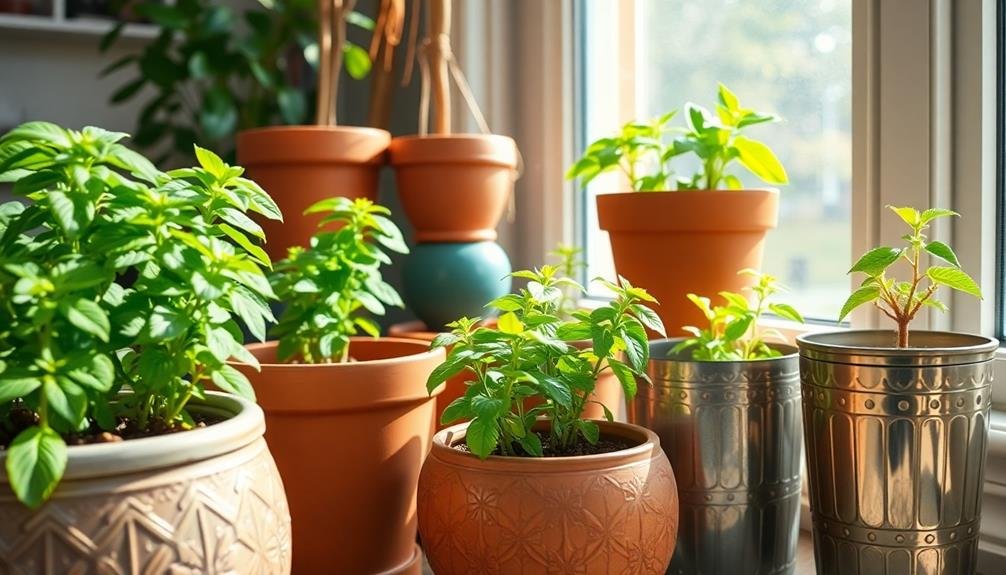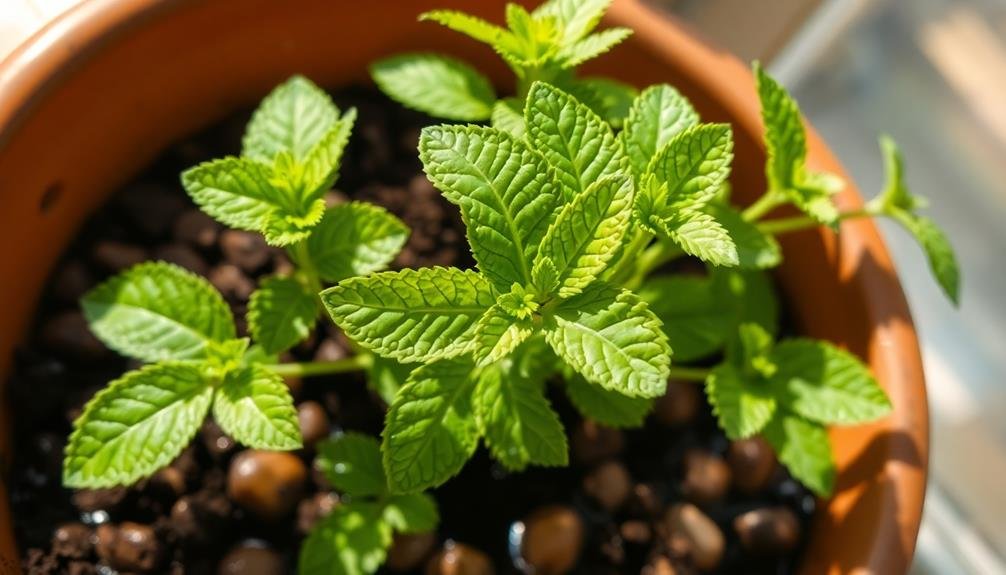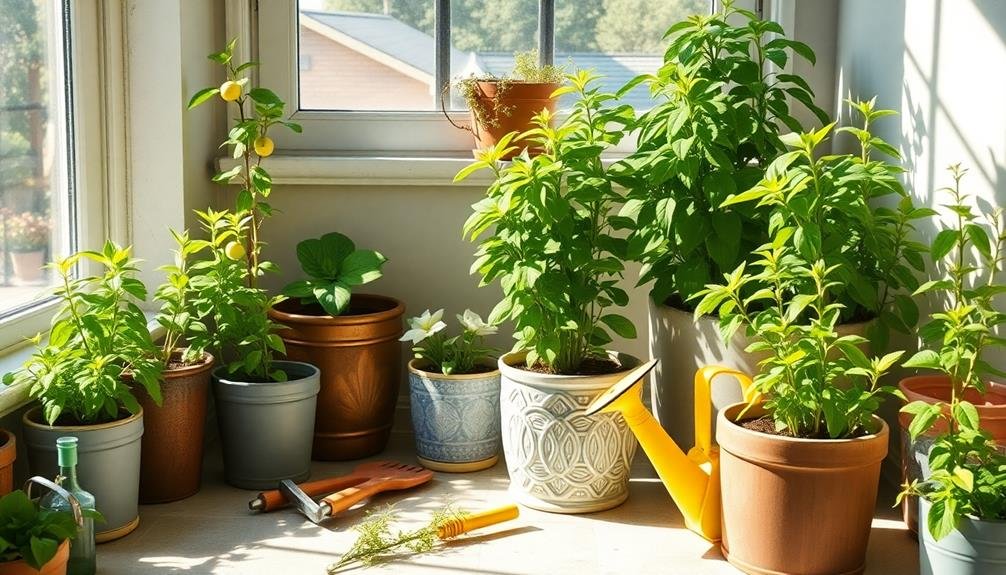Growing lemon balm in indoor containers is easy if you follow these tips. Start by choosing a pot with drainage holes, ideally 6 to 8 inches wide. Use a nutrient-rich, well-draining soil mix for ideal growth. Make sure your plant gets at least six hours of sunlight daily by placing it near a bright window. Water the soil when it feels dry an inch down, and fertilize every four to six weeks during the growing season. Don't forget to prune regularly to encourage bushiness. With these basics in mind, there's so much more you can explore for your indoor herb garden.
Choose the Right Container

When growing lemon balm in indoor containers, selecting the right pot is essential for your plant's health. You'll want to choose a container that provides adequate drainage, as lemon balm doesn't like sitting in water. Look for pots with drainage holes at the bottom to prevent root rot and guarantee your plant thrives.
Size matters too. Opt for a pot that's at least 6 to 8 inches in diameter. This size not only gives the roots room to spread but also helps maintain moisture levels, keeping your lemon balm happy and hydrated. If you're planning to grow multiple plants, reflect on using a larger container to accommodate their growth without overcrowding.
Material is another factor to take into account. Terracotta pots are great because they're porous, allowing air and moisture to circulate. However, plastic pots are lightweight and retain moisture longer. Choose what works best for your environment.
Lastly, think about aesthetics. You'll want a container that fits well with your indoor decor. With the right pot, your lemon balm will flourish, adding beauty and a revitalizing scent to your home.
Select Quality Soil
Selecting quality soil is essential for your lemon balm's success indoors. The right soil not only provides nutrients but also supports healthy growth. When choosing soil, keep these key factors in mind:
- Well-Draining Mix: Opt for a soil mix designed for container gardening. This guarantees excess water drains away, preventing root rot.
- Organic Matter: Look for soil that contains organic compost or peat moss. These components enrich the soil and promote beneficial microbial activity.
- pH Level: Aim for a soil pH between 6.0 and 7.0. You can test pH levels using a simple kit, as lemon balm thrives in slightly acidic to neutral conditions.
- Nutrient-Rich: Choose a soil that's fortified with essential nutrients like nitrogen, phosphorus, and potassium. This will give your lemon balm a strong start and encourage lush, vibrant growth.
Ensure Proper Drainage

To keep your lemon balm thriving, you need to guarantee proper drainage in your containers.
Choose suitable pots with drainage holes and fill them with quality potting mix designed for herbs.
This combination will help prevent waterlogged soil, allowing your plants to flourish.
Choose Suitable Containers
How can you guarantee your lemon balm thrives in containers? Choosing the right container is essential for your plant's health. Start by ensuring that it has adequate drainage, as too much water can lead to root rot.
Here are some tips for selecting suitable containers:
- Size: Pick a container that's at least 6 to 8 inches deep. This gives your lemon balm room to grow.
- Material: Opt for breathable materials like terracotta or ceramic. These types help regulate moisture levels better than plastic.
- Drainage Holes: Make sure your container has several drainage holes at the bottom. This prevents water from pooling and keeps the roots healthy.
- Mobility: Consider lightweight containers with wheels. This makes it easier to move your plants around for ideal light exposure.
Use Quality Potting Mix
After choosing the right container, the next step is to fill it with a quality potting mix that secures proper drainage. Lemon balm thrives in well-draining soil, which prevents water from pooling at the bottom of the pot. This helps avoid root rot, a common issue with indoor plants.
When selecting a potting mix, look for one that contains a blend of components. Here's a quick reference table to help you understand what to look for:
| Component | Purpose | Benefits |
|---|---|---|
| Peat Moss | Retains moisture | Keeps soil slightly damp |
| Perlite | Enhances drainage | Prevents compaction |
| Vermiculite | Improves aeration | Encourages root growth |
| Compost | Provides nutrients | Enriches the soil |
| Bark Fines | Adds structure | Improves drainage |
Mix these components in equal parts to create an ideal blend for your lemon balm. This guarantees that your plant gets the right balance of moisture and air, promoting healthy growth. Remember to check the moisture level regularly to keep your lemon balm thriving indoors!
Optimize Light Conditions
To grow healthy lemon balm, you'll need to guarantee it gets the right amount of light.
Ideally, place your containers where they'll receive at least six hours of direct sunlight each day.
If natural light isn't enough, consider using supplemental lighting options to keep your plants thriving.
Ideal Light Exposure
When growing lemon balm in indoor containers, providing the right light exposure is essential for its health and growth. Lemon balm thrives in bright, indirect sunlight, so you'll want to position your containers accordingly.
Here are some tips to guarantee your plants receive the ideal light:
- Choose a bright windowsill: A south or west-facing window is usually best, as it offers ample light throughout the day.
- Rotate your pots: To promote even growth, rotate your containers every week. This helps all sides of the plant receive equal light exposure.
- Watch for signs of stress: If you notice yellowing leaves or leggy growth, your lemon balm might be getting too little light. Adjust its position as needed.
- Monitor temperature: Keep your plants in an environment where temperatures stay between 65-75°F (18-24°C). Extreme heat or cold can affect their light needs.
Supplemental Lighting Options
Many indoor gardeners find that natural light alone isn't enough to keep their lemon balm thriving, especially during the shorter days of winter. To guarantee your plants receive adequate light, consider investing in supplemental lighting options.
LED grow lights are popular due to their energy efficiency and adjustable spectrum. They provide the right wavelengths for ideal growth without overheating your plants.
Fluorescent lights are another great choice. They produce less heat and can be placed closer to your lemon balm, making sure they capture as much light as possible. Aim for a light schedule of about 12 to 16 hours daily, mimicking the natural daylight your plants would receive outdoors.
You can also use grow light stands or shelves, allowing you to position multiple plants under one light source. If you're looking for something more versatile, consider light timers. They'll help you maintain a consistent light schedule, which is vital for healthy growth.
Remember to monitor your lemon balm for signs of too much light, like leaf scorch, and adjust the distance of your lights accordingly. With the right supplemental lighting, you'll set your indoor lemon balm up for success year-round.
Watering Techniques

Mastering the right watering techniques is essential for thriving lemon balm in indoor containers. This herb loves moisture but can't stand soggy soil, so finding the perfect balance is key. Here are some tips to help you water effectively:
- Check the Soil: Before watering, stick your finger about an inch into the soil. If it feels dry, it's time to water. If it's still moist, wait a day or two.
- Water Evenly: When you do water, make certain you distribute it evenly across the pot. This encourages even root growth and prevents waterlogging.
- Use Quality Drainage: Make sure your pots have drainage holes. Excess water should flow out, preventing root rot and other moisture-related issues.
- Adjust for Humidity: Indoor environments can vary. If you notice the leaves wilting or turning yellow, reassess your watering schedule—higher humidity might mean you need to water less frequently.
Fertilization Practices
Fertilizing lemon balm in indoor containers is essential for promoting healthy growth and vibrant leaves. To get started, choose a balanced, water-soluble fertilizer, ideally with an NPK ratio of 10-10-10. You'll want to feed your lemon balm every four to six weeks during the growing season, which typically runs from spring to early fall.
Before applying fertilizer, make sure the soil is moist. This helps prevent root burn and allows the nutrients to be absorbed more effectively. Dilute the fertilizer according to the package instructions; it's better to under-fertilize than to overdo it. If you notice yellowing leaves, it might be a sign that your plant needs more nutrients.
In the fall and winter, when growth slows down, you can reduce feeding to once every couple of months or stop altogether.
Lemon balm benefits from organic options too; consider using compost or worm castings to enrich the soil naturally. Always keep an eye on your plant's health; adjusting your fertilization practices based on its appearance and growth rate will lead to the best results. Happy gardening!
Pruning and Harvesting Tips

To keep your lemon balm thriving and encourage bushy growth, regular pruning is key. Not only does it promote healthier plants, but it also enhances the flavor of the leaves. Here are some practical pruning and harvesting tips to follow:
- Prune regularly: Trim your lemon balm every few weeks, especially during the growing season. This helps prevent it from becoming leggy and encourages new growth.
- Cut above a leaf node: When you prune, always cut just above a leaf node. This stimulates the plant to produce new branches, resulting in a fuller appearance.
- Harvest leaves selectively: Instead of stripping the entire plant, take only a few leaves at a time. This will allow the plant to keep producing and not become stressed.
- Avoid cutting more than one-third: When harvesting or pruning, never remove more than one-third of the plant at once. This protects its overall health and guarantees continued growth.
Frequently Asked Questions
Can Lemon Balm Be Grown From Seeds or Cuttings?
You can grow lemon balm from both seeds and cuttings. If you choose seeds, start them indoors, while cuttings should be taken from healthy plants. Either method can lead to flourishing lemon balm in your garden.
What Pests Commonly Affect Indoor Lemon Balm Plants?
When you grow lemon balm indoors, watch out for pests like aphids, spider mites, and whiteflies. They can damage your plants, so keep an eye on them and take action if you notice any infestations.
How Do I Tell if My Lemon Balm Is Overwatered?
You can tell if your lemon balm's overwatered by checking for yellowing leaves, wilting despite moist soil, or a mushy stem. Adjust your watering schedule to guarantee it drys out slightly between waterings.
Is Lemon Balm Safe for Pets and Children?
Yes, lemon balm is generally safe for pets and children. It's non-toxic and can even be soothing. However, always supervise and consult a veterinarian if you notice any unusual behavior after ingestion.
Can I Use Lemon Balm for Culinary or Medicinal Purposes?
Yes, you can definitely use lemon balm for culinary and medicinal purposes. It adds a invigorating flavor to dishes and teas, plus its calming properties may help relieve stress and promote better sleep. Enjoy experimenting!
In Summary
By following these tips, you can successfully grow lemon balm in indoor containers. Choose the right container and quality soil, make certain proper drainage, and optimize light conditions to create a thriving environment. Don't forget to pay attention to your watering techniques and fertilization practices, as they're key to healthy growth. Finally, regular pruning and harvesting will keep your plant bushy and productive. Enjoy the fresh aroma and flavor of your homegrown lemon balm!





Leave a Reply